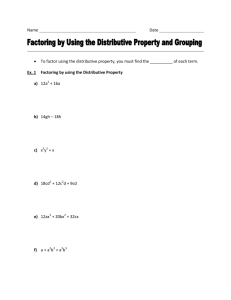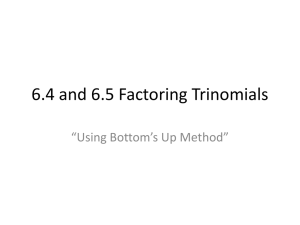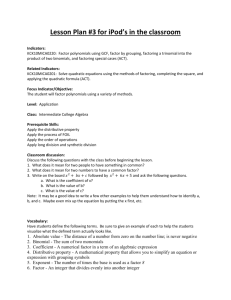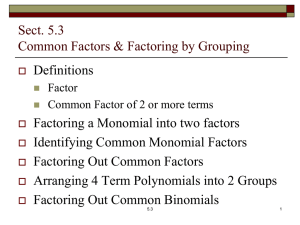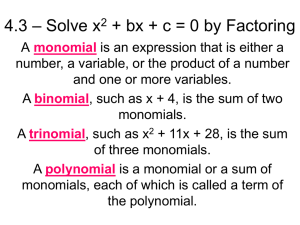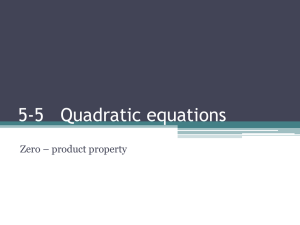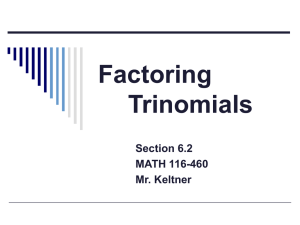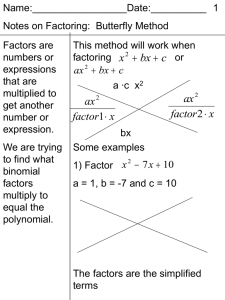5.4
advertisement
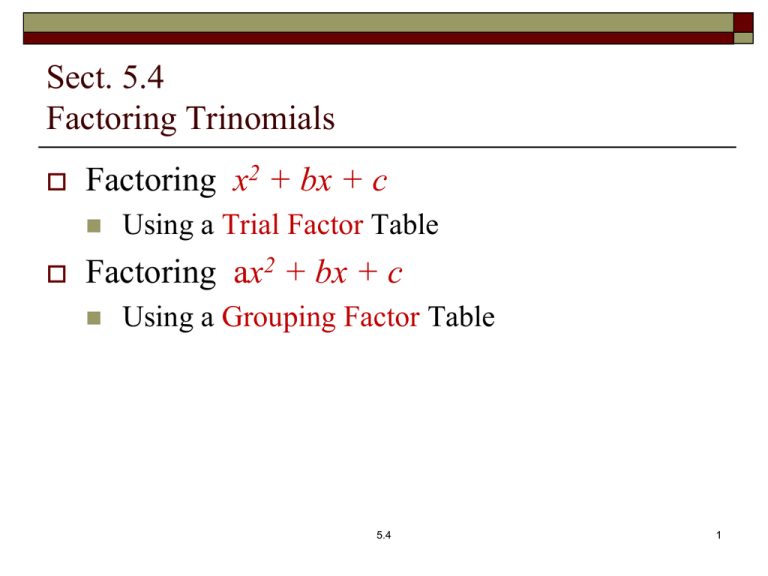
Sect. 5.4 Factoring Trinomials Factoring x2 + bx + c Using a Trial Factor Table Factoring ax2 + bx + c Using a Grouping Factor Table 5.4 1 Remember FOIL? (x + )(x + ) Examine the trinomial: You can predict the Binomial operation signs 5.4 (x – )(x – ) (x + )(x – ) (x + )(x –2 ) Factoring Trinomials with Leading Coefficient=1 x2 + bx + c b and c are #s 1. Write the trinomial in descending powers of one variable. 2. First - remove any common factor (there may not be one) 3. (not in book) Write down the binomial factor pair with middle operators + or – 4. Create a “Trial Factor Table”: 4.1 List the possible factor pairs of the 3rd term’s coefficient. Factor x 7 x 12 2 Therefore: (x – 3 )(x – 4 ) factor pairs of 12 factor sum = -7 -1 x -12 -2 x -6 -3 x -4 4.2 List their corresponding sums. 5. Use the factor pair where the sum of the factors is the coefficient of the middle term. 5.4 -1 + -12 = -13 no -2 + -6 = -8 no -3 + -4 = -7 yes! 3 Using a Factor Table for x2 + bx + c - Organized Trial & Error Let’s use x2 + 13x + 36 as an example Factors must both be sums: (x + ?)(x + ?) Pairs=c=36 Sum=b=13 1, 36 37 2, 18 20 3, 12 15 4, 9 13 ok quit! x2 + 13x + 36 = (x + 4)(x + 9) 5.4 4 Factoring Practice: x 9x 8 c8 | b9 ( x )( x ) 1,8 2 | 9 yes ( x 1)( x 8 ) y 20 9 y 2 y 9 y 20 2 c 20 | b 9 ( y )( y ) 1, 20 | 21 ( y 4 )( y 5 ) 2 , 10 | 12 4 , 5 | 9 yes 5.4 5 Factoring Practice: x x 30 x 3 2 x ( x x 30 ) c 30 | b 1 x ( x )( x ) 1, 30 | 29 x ( x 5 )( x 6 ) 2 , 15 | 13 2 3 , 10 | 7 5, 6 | 1 yes 5.4 6 Factoring Practice: 2 x 34 x 220 2 2 ( x 17 x 110 ) 2 2 ( x )( x ) 2 ( x 22 )( x 5 ) 5.4 7 “Can’t Factor”? x2 – x – 7 x2 + 3x – 42 When There are 2 Variables x2 – 2xy – 48y2 5.4 8 Factor by Grouping 8t3 + 2t2 – 12t – 3 2t2(4t + 1) – 3(4t + 1) (4t + 1)(2t2 – 3) 4x3 – 6x2 – 6x + 9 2x2(2x – 3) – 3(2x – 3) (2x – 3)(2x2 – 3) y4 – 2y3 – 12y – 3 y3(y – 2) – 3(4y – 1) Oops – not factorable via grouping 5.4 9 Factoring ax2 + bx + c (a not 1 or 0) Factoring by Guessing 1. Write the trinomial in descending powers of one variable. 2. Factor out any greatest common factor (including 1, if that is necessary to make the coefficient of the first term positive). 3. Determine the signs of the factors: (assume a is positive) If c is + then both factors would need to have the sign of b If c is – then the factors must have different signs 4. Try various combinations of the factors of the first terms and the last terms until either: You find a pair of binomial factors that work, or Try all possible combinations but none work. (unfactorable) 5. Check the factorization by multiplication. Let’s guess: 3p2 – 4p – 4 = (3p 5.4 )(p ) 10 Use Grouping to Factor 16 + 24x + 5x2 5x2 + 24x + 16 (first rearrange) ac = 5(16) = 2· 2· 2· 2· 5 1 · 80 2 · 40 4 · 20 b = 24 1 + 80 = 81 2 + 40 = 42 4 + 20 = 24 5x2 + 4x + 20x + 16 x(5x + 4) + 4(5x + 4) (5x + 4)(x + 4) ta-da! 5.4 No No YES 11 The ac Grouping Method: ax2 + bx + c Split bx into 2 Terms: Use a Grouping Factor Table Let’s use 3x2 – 10x – 8 as an example ac = 3(-8) = -24 One factor is positive, the other negative and larger. Pairs=ac=3(-8) =-2·2·2·3 Sum=b=-10 1, -24 -23 2, -12 -10 quit! 3, -8 -5 4, -6 -2 3x2 – 10x –8= 3x2 + 2x – 12x – 8 = split the middle x(3x + 2) – 4(3x + 2) = do grouping (3x + 2)(x – 4) 5.4 12 ac Factoring Practice 1: 3x2 + 10x – 8 5.4 13 ac Factoring Practice 2: 6x6 – 19x5 + 10x4 5.4 14 ac Factoring Practice 3: 6x4 – 116x3 – 80x2 5.4 15 What Next? Section 5.5 – Factoring Perfect Squares & Differences of Squares 5.4 16
